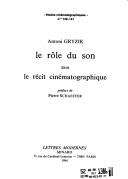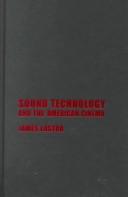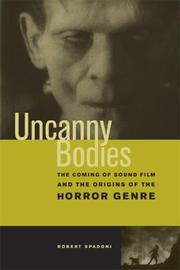| Listing 1 - 5 of 5 |
Sort by
|
Book
ISBN: 2700002555 9782700002553 Year: 1979 Publisher: Paris: Gründ,
Abstract | Keywords | Export | Availability | Bookmark
 Loading...
Loading...Choose an application
- Reference Manager
- EndNote
- RefWorks (Direct export to RefWorks)
Sound --- Sound motion pictures --- Radio --- Television --- Son --- Télévision --- Recording and reproducing --- History. --- Enregistrement et reproduction --- Histoire --- History --- Télévision --- Sound - Recording and reproducing - History --- Sound motion pictures - History --- Radio - History --- Television - History

ISBN: 2256908313 9782256908316 Year: 1984 Volume: 47 Publisher: Paris: Lettres modernes Minard,
Abstract | Keywords | Export | Availability | Bookmark
 Loading...
Loading...Choose an application
- Reference Manager
- EndNote
- RefWorks (Direct export to RefWorks)
Sound motion pictures --- Motion pictures --- Films sonores --- Cinéma --- History and criticism --- Sound effects --- Histoire et critique --- Son --- History --- film --- filmtechniek --- klank --- 791.42 --- 791.41 --- filmmuziek --- filmtheorie --- narratologie --- muziek --- geluid --- Cinéma --- Sound motion pictures - History
Book
ISBN: 2913787592 9782913787599 Year: 2007 Publisher: Paris: AFRHC,
Abstract | Keywords | Export | Availability | Bookmark
 Loading...
Loading...Choose an application
- Reference Manager
- EndNote
- RefWorks (Direct export to RefWorks)
À la fin des années vingt, le marché français est largement dominé par le cinéma américain. Le succès des films parlants, fondé sur la popularité des acteurs français, relance l’industrie du cinéma. Le parlant constitue une nouvelle chance pour le cinéma français. Après le départ de leurs fondateurs, les sociétés Pathé et Gaumont tentent d’adapter en France le modèle hollywoodien de la compagnie intégrée de cinéma. Mais l’amortissement des investissements effectués pour l’adaptation au parlant et la rénovation des salles s’avère difficile au moment de la baisse des recettes de 1933-1934 : la Gaumont-Franco-Film-Aubert est mise en liquidation judiciaire en 1934 et Pathé-Cinéma en faillite en 1936.L’échec de l’aventure de ces grandes compagnies provoque la première grande réflexion politique sur le statut du cinéma en France avec les rapports Petsche et de Carmoy. entre 1934 et 1939 s’élabore peu à peu un “modèle français” de cinématographie qui accorde à l’État un rôle d’encadrement et de soutien aux petites entreprises. Malgré les polémiques, les mesures protectionniste restent modestes. En 1939, le rôle nouveau de l’État s’affirme avec le décret sur le contrôle des recettes. La comptabilité de nombreuses salles, l’étude du fonctionnement des studios, des devis, des budgets de films et des contrats de distribution permettent de décrire l’évolution des différents stades de la filière cinématographique – production, distribution et exploitation – à partir de documents d’archives publiques et privées. Cette analyse confirme le caractère limité, tant en ampleur qu’en durée, de la crise en France. Pourtant, celle-ci a suffi à déséquilibrer les grandes compagnies.
Sound motion pictures --- Motion pictures --- Motion picture industry --- History. --- Economic aspects --- Finance. --- Sound motion pictures - History --- Motion pictures - France - History --- Motion picture industry - France --- Motion pictures - Economic aspects - France --- History of cinema industry --- 20th century. --- Cinéma --- Industrie cinématographique --- France --- 1929-1945 --- Histoire et critique --- 1900-1945 --- Aspect économique --- Cinéma --- Industrie cinématographique --- Aspect économique

ISBN: 0231115172 0231115164 0231505469 Year: 2000 Publisher: New York, NY : Columbia University Press,
Abstract | Keywords | Export | Availability | Bookmark
 Loading...
Loading...Choose an application
- Reference Manager
- EndNote
- RefWorks (Direct export to RefWorks)
Representational technologies including photography, phonography, and the cinema have helped define modernity itself. Since the nineteenth century, these technologies have challenged our trust of sensory perception, given the ephemeral unprecedented parity with the eternal, and created profound temporal and spatial displacements. But current approaches to representational and cultural history often neglect to examine these technologies. James Lastra seeks to remedy this neglect.Lastra argues that we are nowhere better able to track the relations between capital, science, and cultural practice than in photography, phonography, and the cinema. In particular, he maps the development of sound recording from its emergence to its confrontation with and integration into the Hollywood film.Reaching back into the late eighteenth century, to natural philosophy, stenography, automata, and human physiology, Lastra follows the shifting relationships between our senses, technology, and representation.
Sound motion pictures --- -Sound --- -#SBIB:012.AANKOOP --- #SBIB:309H1325 --- James Lastra --- film --- Verenigde Staten --- filmtheorie --- klank --- geluid --- geluidsfilm --- klanktechniek --- klanktechnologie --- film en technologie --- narratologie --- stille film --- 791.41 --- Acoustics --- Continuum mechanics --- Mathematical physics --- Physics --- Pneumatics --- Radiation --- Wave-motion, Theory of --- Moving-pictures, Talking --- Talkies --- Talking motion pictures --- Motion pictures --- History --- Recording and reproducing --- -History --- Films met een amusementsfunctie en/of esthetische functie: filmmuziek --- Sound --- Son --- History. --- Enregistrement et reproduction --- Histoire --- Films sonores --- History and criticism --- Histoire et critique --- #SBIB:012.AANKOOP --- Recording and reproducing&delete& --- Recording and reproducing. --- Sound. --- Sound -- Recording and reproducing -- History. --- Sound motion pictures. --- Sound motion pictures -- History. --- Film --- Music, Dance, Drama & Film

ISBN: 9780520251229 9780520251212 0520251210 0520251229 128138562X 0520940709 9786611385620 1435653653 9780520940703 6611385622 9781435653658 9781281385628 Year: 2007 Publisher: Berkeley : University of California Press,
Abstract | Keywords | Export | Availability | Bookmark
 Loading...
Loading...Choose an application
- Reference Manager
- EndNote
- RefWorks (Direct export to RefWorks)
In 1931 Universal Pictures released Dracula and Frankenstein, two films that inaugurated the horror genre in Hollywood cinema. These films appeared directly on the heels of Hollywood's transition to sound film. Uncanny Bodies argues that the coming of sound inspired more in these massively influential horror movies than screams, creaking doors, and howling wolves. A close examination of the historical reception of films of the transition period reveals that sound films could seem to their earliest viewers unreal and ghostly. By comparing this audience impression to the first sound horror films, Robert Spadoni makes a case for understanding film viewing as a force that can powerfully shape both the minutest aspects of individual films and the broadest sweep of film production trends, and for seeing aftereffects of the temporary weirdness of sound film deeply etched in the basic character of one of our most enduring film genres.
Horror films --- Sound motion pictures --- Films d'horreur --- Films sonores --- History and criticism. --- Histoire et critique --- 82:791.43 --- Literatuur en film --- Horror films - United States - History and criticism. --- Horror films. --- Sound motion pictures - History and criticism. --- Film --- Music, Dance, Drama & Film --- History and criticism --- 82:791.43 Literatuur en film --- Moving-pictures, Talking --- Talkies --- Talking motion pictures --- Motion pictures --- 20th century american culture. --- 20th century american film history. --- american culture. --- american film history. --- american movie history. --- audience reception. --- cinema. --- classic horror cinema. --- dark. --- dracula. --- early sound film. --- film studies. --- filmmaking. --- frankenstein. --- hollywood cinema. --- horror genre. --- horror movies. --- intense. --- modality. --- movie studies. --- sound film. --- svengali. --- the hollywood review of 1929. --- uncanny theater. --- united states of america. --- universal pictures. --- vampires. --- ventriloquism.
| Listing 1 - 5 of 5 |
Sort by
|

 Search
Search Feedback
Feedback About UniCat
About UniCat  Help
Help News
News